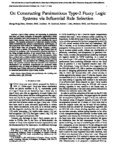On Constructing Parsimonious Type-2 Fuzzy Logic Systems via Influential Rule Selection
| dc.contributor.author | Shang-Ming Zhou, | |
| dc.contributor.author | Garibaldi, JM | |
| dc.contributor.author | John, RI | |
| dc.contributor.author | Chiclana, F | |
| dc.date.accessioned | 2023-02-15T13:08:30Z | |
| dc.date.available | 2023-02-15T13:08:30Z | |
| dc.date.issued | 2009-06 | |
| dc.identifier.issn | 1063-6706 | |
| dc.identifier.issn | 1941-0034 | |
| dc.identifier.uri | http://hdl.handle.net/10026.1/20373 | |
| dc.description.abstract |
Type-2 fuzzy systems are increasing in popularity, and there are many examples of successful applications. While many techniques have been proposed for creating parsimonious type-1 fuzzy systems, there is a lack of such techniques for type-2 systems. The essential problem is to reduce the number of rules, while maintaining the system's approximation performance. In this paper, four novel indexes for ranking the relative contribution of type-2 fuzzy rules are proposed, which are termed values, c-values, ω1-values, and ω2 -values. The R-values of type-2 fuzzy rules are obtained by applying a QR decomposition pivoting algorithm to the firing strength matrices of the trained fuzzy model. The c-values rank rules based on the effects of rule consequents, while the ω1-values and ω2-values consider both the rule-base structure (via firing strength matrices) and the output contribution of fuzzy rule consequents. Two procedures for utilizing these indexes in fuzzy rule selection (termed "forward selection"and "backward elimination") are described. Experiments are presented which demonstrate that by using the proposed methodology, the most influential type-2 fuzzy rules can be effectively retained in order to construct parsimonious type-2 fuzzy models. © 2009 IEEE. | |
| dc.format.extent | 654-667 | |
| dc.language.iso | en | |
| dc.publisher | Institute of Electrical and Electronics Engineers (IEEE) | |
| dc.subject | Parsimony | |
| dc.subject | QR | |
| dc.subject | ranking index | |
| dc.subject | rule ranking | |
| dc.subject | rule selection | |
| dc.subject | singular-value decomposition-QR (SVD-QR) | |
| dc.subject | type-2 fuzzy sets | |
| dc.title | On Constructing Parsimonious Type-2 Fuzzy Logic Systems via Influential Rule Selection | |
| dc.type | journal-article | |
| dc.type | Journal Article | |
| plymouth.author-url | https://www.webofscience.com/api/gateway?GWVersion=2&SrcApp=PARTNER_APP&SrcAuth=LinksAMR&KeyUT=WOS:000266677000014&DestLinkType=FullRecord&DestApp=ALL_WOS&UsrCustomerID=11bb513d99f797142bcfeffcc58ea008 | |
| plymouth.issue | 3 | |
| plymouth.volume | 17 | |
| plymouth.publication-status | Published | |
| plymouth.journal | IEEE Transactions on Fuzzy Systems | |
| dc.identifier.doi | 10.1109/tfuzz.2008.928597 | |
| plymouth.organisational-group | /Plymouth | |
| plymouth.organisational-group | /Plymouth/Faculty of Health | |
| plymouth.organisational-group | /Plymouth/Faculty of Health/School of Nursing and Midwifery | |
| plymouth.organisational-group | /Plymouth/REF 2021 Researchers by UoA | |
| plymouth.organisational-group | /Plymouth/REF 2021 Researchers by UoA/UoA03 Allied Health Professions, Dentistry, Nursing and Pharmacy | |
| plymouth.organisational-group | /Plymouth/Users by role | |
| plymouth.organisational-group | /Plymouth/Users by role/Academics | |
| dc.identifier.eissn | 1941-0034 | |
| dc.rights.embargoperiod | Not known | |
| rioxxterms.versionofrecord | 10.1109/tfuzz.2008.928597 | |
| rioxxterms.licenseref.uri | http://www.rioxx.net/licenses/all-rights-reserved | |
| rioxxterms.type | Journal Article/Review |


